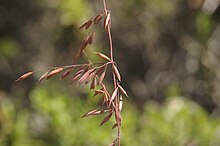Ehrharta calycina is a species of grass known by the common names perennial veldtgrass and purple veldtgrass.
| Ehrharta calycina | |
|---|---|

| |
| Scientific classification | |
| Kingdom: | Plantae |
| Clade: | Tracheophytes |
| Clade: | Angiosperms |
| Clade: | Monocots |
| Clade: | Commelinids |
| Order: | Poales |
| Family: | Poaceae |
| Genus: | Ehrharta |
| Species: | E. calycina
|
| Binomial name | |
| Ehrharta calycina | |
Distribution
editIt is native to southern Africa; from South Africa (within the Cape Provinces, Free State and KwaZulu-Natal), Lesotho and Namibia.[1]
It grows in Veld grassland habits and on low-lying sandy areas.[2]
Description
editEhrharta calycina is a highly variable perennial grass, often but not always rhizomatous.
It usually reaches 30–70 centimetres (12–28 in) in height, but is known to grow much taller in favorable conditions.
The inflorescence is a narrow to wide open array of spikelets light in color when new and becoming darker and tinted purple to reddish with age.
Taxonomy
editThe Latin specific epithet of calycina is derived from calycinus meaning like a calyx or with a prominent calyx.[3] It was first described and published in Pl. Icon. Ined. on table 33 in 1789.[1]
Introduced / invasive species
editThe grass is an introduced species, including places such as; California, Egypt, Hawaii, India, New South Wales, New Zealand North, Portugal, South Australia, Spain, Tasmania, Texas, Tunisia, Victoria and Western Australia.[1] Sometimes becoming a noxious weed outside its native range.
It is an invasive species in California, where it is an invasive weed of chaparral and coastal sage scrub habitat along the southern and central coastal regions.[4] It was first introduced to Davis in the Sacramento Valley as a drought-tolerant range grass for grazing.[5][6]
It is also known as an invasive species and weed in parts of Australia.
The species has been added to the list of invasive alien species of Union Concern.[7] This means it is now forbidden to trade, import and breed this plant in all Member States of the European Union.[8]
References
edit- ^ a b c "Ehrharta calycina Sm. | Plants of the World Online | Kew Science". Plants of the World Online. Retrieved 13 January 2022.
- ^ Vermeulen, H.C.; Nel, J.A.J. (1988). "The bush Karoo rat Otomys unisulcatus on the Cape West coast". S. Afr. J. Zoo. 23 (2).
- ^ Harrison, Lorraine (2012). RHS Latin for Gardeners. United Kingdom: Mitchell Beazley. ISBN 184533731X.
- ^ California Invasive Plant Council: Ehrharta calycina profile
- ^ "FAO Profile". Archived from the original on 2008-07-27. Retrieved 2009-05-13.
- ^ "Grass Manual Treatment". Archived from the original on 2011-06-11. Retrieved 2009-05-13.
- ^ "European Regulation on IAS". June 2021. Archived from the original on 2017-07-29.
- ^ "European Regulation on IAS". June 2021. Archived from the original on 2015-09-10.
External links
edit- Jepson Manual Treatment — invasive plant species in California.
- USDA Plants Profile — invasive plant species in U.S.
- UC CalPhoto gallery of Ehrharta calycina